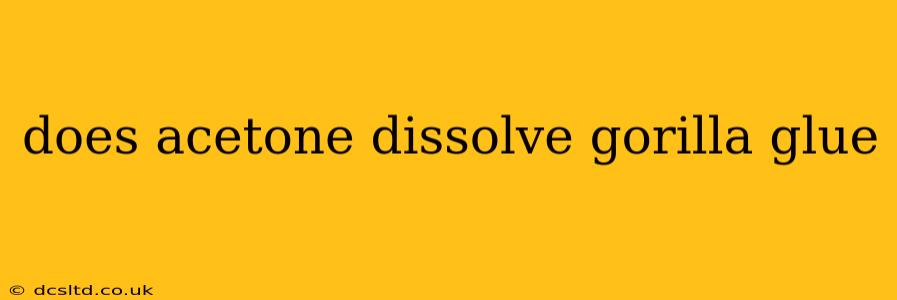Gorilla Glue, known for its incredibly strong bond, can sometimes present a challenge when removal is necessary. Many turn to acetone, a powerful solvent, hoping for a solution. But does acetone actually dissolve Gorilla Glue? The answer, unfortunately, isn't a simple yes or no. The effectiveness depends on several factors, which we'll explore in detail.
What is Gorilla Glue, and Why is it So Difficult to Remove?
Gorilla Glue is a polyurethane-based adhesive. This means it undergoes a chemical reaction as it cures, forming strong, rigid bonds. Unlike some other adhesives that simply dry, Gorilla Glue expands as it cures, penetrating deeply into the materials it joins. This expansion and chemical change are what make it so incredibly strong and, consequently, so difficult to remove.
Does Acetone Dissolve Gorilla Glue? The Complex Answer
Acetone, a common solvent found in nail polish remover, can soften Gorilla Glue, making it easier to remove. However, it won't completely dissolve it in the way it might dissolve some other adhesives. The cured polyurethane bonds are highly resistant to acetone. Think of it more like weakening the glue rather than completely eliminating it. This means you'll likely need to combine acetone with other methods for effective removal.
How Effective is Acetone in Removing Gorilla Glue?
The effectiveness of acetone depends on several factors:
- The type of Gorilla Glue: Different Gorilla Glue products may react differently to acetone.
- The age of the glue: Fresh glue is generally more susceptible to acetone than glue that has had time to fully cure.
- The surface the glue is on: Porous surfaces may absorb the acetone before it can effectively soften the glue.
- The application method: Simply applying acetone may not be enough; you'll likely need to use it in conjunction with scraping or other removal techniques.
What are the Best Methods for Removing Gorilla Glue?
While acetone can play a helpful role, it's rarely the sole solution. A multi-pronged approach is usually necessary. This could involve:
- Mechanical removal: Carefully scraping or sanding away the softened glue.
- Heat: Applying heat with a hairdryer (carefully!) can soften the glue, making it easier to remove.
- Commercial glue removers: Specific products designed for removing polyurethane adhesives are often more effective than acetone alone.
How to Use Acetone Safely and Effectively for Gorilla Glue Removal
If you choose to use acetone, remember safety precautions:
- Ventilation: Acetone is volatile and has strong fumes. Work in a well-ventilated area or outdoors.
- Protection: Wear gloves and eye protection to prevent skin and eye irritation.
- Test: Always test acetone on an inconspicuous area of the surface first to ensure it doesn't damage the material.
- Application: Apply acetone sparingly and let it sit for a few minutes to soften the glue before attempting removal. Avoid prolonged soaking, as this may damage the underlying surface.
Is there a specific type of acetone that works best?
The concentration of acetone doesn't significantly impact its effectiveness on Gorilla Glue. Pure acetone (100%) is readily available but not necessarily superior to lower concentrations for this specific task. The key is the application method and combining it with other removal techniques.
Can I use acetone on all surfaces?
No, acetone is a harsh solvent and can damage certain surfaces like some plastics, painted surfaces, and certain fabrics. Always test in an inconspicuous area first.
What should I do if acetone doesn't work?
If acetone isn't effective enough, consult a professional cleaning service or consider using a commercial glue remover specifically designed for polyurethane adhesives.
This comprehensive guide should offer a clearer understanding of acetone's role in Gorilla Glue removal. Remember that patience and a multi-faceted approach are key to successful removal. Always prioritize safety and test any solvent on an inconspicuous area before widespread application.
